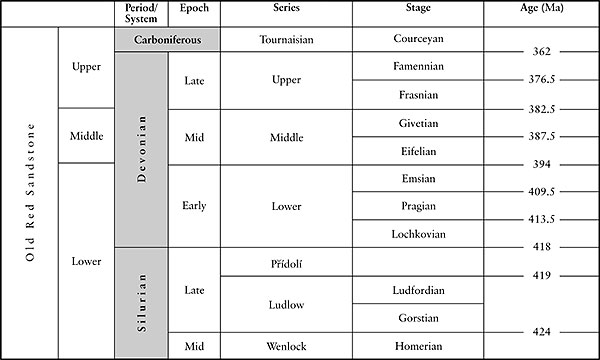What is the Old Red Sandstone?
The term Old Red Sandstone was first used to describe
those deposits in the Welsh basin and described as part of the Lower
Carboniferous. It was a naturalist called Robert Jameson who coined the term
(ORS) in 1820 to describe the rocks underlying the Mountain (Carboniferous)
Limestone. Murchison was the first to realise the ORS was a separate entity
giving it the status of system, which for the next century was broadly
correlated with the Devonian that he went on to describe with Sedgwick. With
modern stratigraphical methods it has merely become a classic term describing
the terrestrial largely clastic facies of the late Silurian to the lowest
Carboniferous but is still commonly split into Its Lower (LORS) Middle (MORS)
and Upper subdivisions.

The Old Red Sandstone is also found in Russia, the
Baltic countries, Greenland, Poland, Norway and North America, often containing
fish of the same genus if not species. The ORS was conceived in a period of
continents colliding and ancient oceans closing. Exactly how and when the
smaller continents of Avalonia and Baltica collided with the supercontinent of
Laurentia is still a matter of debate, but by the late Silurian, with the Lapetus
ocean closed the Old Red Sandstone Continent was born in an event known as the
Caledonian Orogeny.
Marine fossils are the main way used to correlate deposits of rock, but being mainly terrestrial, this is not possible in the ORS so instead, local stage names have been used within and between the basins (e.g. Downtonian and Dittonian).

The Orcadian Basin (Orkney, NE Scotland and Shetland), the Midland Valley, the Scottish Border Basin, the Mell Fell Trough (Southern Lake District) and the Anglo-Welsh Basin. Best known are the MORS localities of the Orcadinan basin, where Miller and Dick once collected and which still yield world-class ichthyolites. Achanarras Quarry and Tynet Burn are favourites of the author but Rhynie (all be it fishless) is a truly fascinating environment. The sites of the Midland Valley are less known but tend to be LORS and Upper ORS, with little in the MORS. Turin Hill in the Midland Valley (LORS) is my absolute favourite site and the history of collecting there, starting with James Powrie, is just as interesting as any of that age. To the best of my knowledge there are no exposures containing articulated fossil fish in the Scottish Borders Basin. The famous sites of the Welsh Border Basin tend to be LORS and Upper Silurian and Lower Devonian in age. The exceptional material tends to ge found in lenses and the famous sites of Devils Hole, Heol Senni Quarry, Cwm Mill and Ledbury Cutting have produced some exceptional articulated fish. Rocks were also being laid down in the SW of England during this period, (hence the name Devonian) although being of marine origin were not included in the Old Red Sandstone (see violet are above)